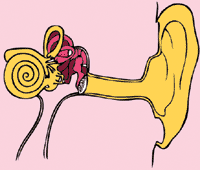What Is Auditory Perception?

Myklebust defines auditory perception as the ability to "structure the auditory world and select those sounds which are immediately pertinent to adjustment." Berry and Eisenson state that children with auditory perceptual deficits can hear sounds but are unable to recognize them for meaning. Defined as the ability to recognize or interpret what is heard, auditory perception plays as important a role as visual perception in reading.
Problems in auditory perception generally correspond to those in the visual area and are presented under the following components:
- Auditory discrimination. This refers to the ability to hear similarities and differences between sounds. The child who has a problem in this area is unable to identify gross differences as between a siren and a school bell or phonemic difference as between words /pen/ and /pin/ or /big/ and /pig/.
- Auditory foreground-background differentiation. This refers to the ability to select and attend to relevant auditory stimuli and ignore the irrelevant. The child who has a difficulty in this area is unable to make such differentiation. As a consequence, everything heard is attended to equally. Thus, the teacher’s voice is lost in the background noises of other children’s whispers or the voices in the corridor or the traffic sounds coming from the street.
- Auditory blending. Also referred to as auditory analysis and synthesis, this is the ability to synthesize individual sounds which form a word. The child who manifests a difficulty in this area is unable to blend the individual sounds in a word, such as /c-a-t/. The child may know the individual phonemes but simply cannot put them together. Similarly, the child may have problems breaking apart an unknown word by syllables and blending it, such as /te-le-phone/.
- Auditory sequencing. This refers to the ability to remember the order of individual sounds in a given stimulus. The child who has problems in this area is unable to recite the alphabet or numbers or recall or carry out orally given directions in the order in which they are presented.
Characteristically, according to Hayes, the child with auditory perception problems (1) may seem to ignore verbal directions; (2) may appear to daydream; (3) asks for repetitions of directions or says “what?”, “huh?”, often; (4) watches everyone else to see what they are doing before following directions; (5) may have poor speech patterns; (6) may be monosyllabic or may not volunteer information; (7) may tend to gesticulate a lot; and (8) usually prefers visual tasks.
|
Edublox provides multisensory cognitive enhancement programs, effective in improving a variety of cognitive skills including auditory perception.
|
Source: Sutaria, S. D., Specific Learning Disabilities: Nature and Needs (Spingfield: Charles C Thomas, 1985).
|
